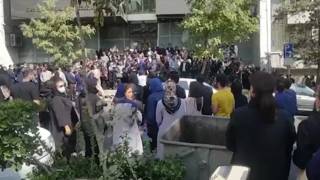
Anti-government protests in Iran, first sparked last month by the death of 22-year-old Mahsa Amini, have moved into their fourth week. The youth- and women-led protests cross class and ethnic divides, and the demands have grown in scale and scope, with many, even in the clerical community, now calling for the complete abolition of the Islamic Republic. Many sectors of society, including businesses and unions, have also joined in protest, with oil workers from one of the country’s major refineries going on strike Monday. Iranian authorities have launched a violent assault on protesters in response, explains Amnesty International’s Raha Bahreini, with security forces shooting live ammunition into crowds to disperse the protests, leaving thousands injured and at least 144 victims dead, 24 of them children. The government violence is “indicative of just what a threat the regime believes these protests are,” argues Iranian American scholar Reza Aslan, who says that despite numerous revolutions in Iran’s history, “this time feels different.”
This content originally appeared on Democracy Now! and was authored by Democracy Now!.